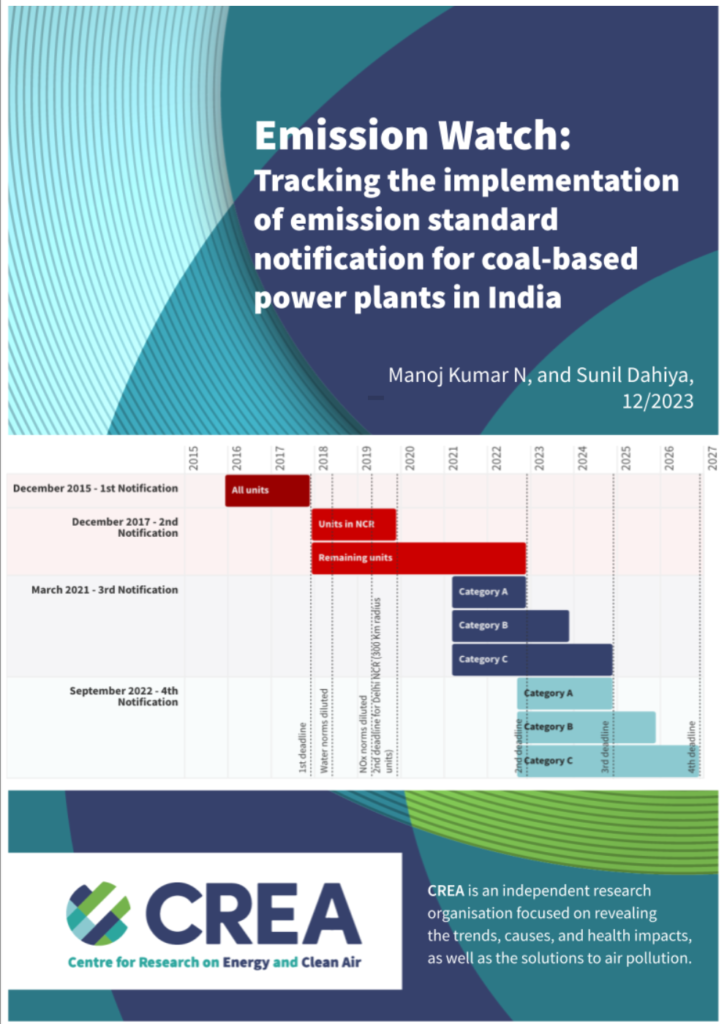Marking the eighth anniversary since the announcement of the first-ever emission standards regulating SO2 (sulphur dioxide), NOx (nitrogen oxides), Hg (mercury), and water consumption in coal-based power generation units across India, the Centre for Research on Energy and Clean Air (CREA) conducted a comprehensive analysis. The findings reveal that over 92% of the active coal capacity in India continues to function without implementing adequate emission controls for SO2 emissions.
The examination reveals the lack of progress despite extending the deadline in September 2022.
Key findings
- National
- Eight years after the notification of emission standards for coal-based electricity generation units in India only 77 units with a combined capacity of 16.5 GW have installed FGD (24 units, 10.6 GW) or CFBC (53 units, 5.9 GW), which is less than 8% of the total coal-based electricity generation capacity;
- only 3.2 GW capacity across 6 units have installed SO2 control technologies over the last year (since December 2022), taking the total capacity with SO2 control to 16.5 GW;
- only 3.5 GW new capacity (10 units) have entered the bid awarded stage since December 2022, taking the total capacity in the bid award stage to 103 GW;
- only 6 GW new capacity (20 units) have opened the bids since December 2022, taking the total capacity in bid opened stage to 52.4 GW;
- In December 2020 a capacity of 26.8 GW across 92 units was in the feasibility study started/completed stage which in October 2023 still remains as high as 22.5 GW across 77 units;
- Based on progress during past years and the fact that it takes 18-36 months to synchronize FGD after the bid award date, most of the capacity (>88 GW) in the pre-bid award stage (bid opened, tender specification made, feasibility study started/completed/not started stage) is at the risk of missing the third time extended deadlines in all categories (category A, B & C).
- Power plant units in the 300 Km radius of Delhi-NCR:
- The 300 km radius around Delhi-NCR hosts 12 coal-based electricity generation plants (36 units) with a cumulative capacity of 13.4 GW, out of which as of October 2023:
- FGD/DSI installation has been completed for seven units with 2.6 GW installed capacity;
- bids have only been awarded for 6 units, with 3.4 GW capacity;
- notice inviting tenders (NIT) have been issued for 13 units, with a capacity of 3.8 GW;
- bids for two units, with a capacity of 0.5 GW, have been opened;
- tender specifications have been made for three units, totalling two GW; and
- four units with a cumulative capacity of 0.9 GW were at feasibility studies completed, while the feasibility study has been initiated for 1 unit (0.1 GW).
- National Thermal Power Corporation (NTPC):
- Out of NTPC’s total 56.3 GW coal capacity monitored by Central Electricity Authority (CEA) for FGD installation, only 3.6 GW across nine units has installed FGD as of October 2023, leaving 50.7 GW capacity across 114 units at bid award stage, six units (1.1 GW) are at NIT issued stage and haven’t shown any progress since December 2020.
- 0.7 GW capacity across eight units has been retired at Muzaffarpur and Talcher (Old) power plants, and two units of 105 MW each are planned to be decommissioned.
- Only three units have installed FGD since December 2022, taking the total number of NTPC coal-based power plant units with FGD to nine.
- No new bids have been awarded since December 2022
- Out of 40 units (22.5 GW) that awarded bids in 2018, only eight units with 3.2 GW capacity have successfully installed FGD; the rest 32 units (19.4 GW) still haven’t completed the FGD installation process despite taking around 60 months (5 years) since the bid award date.
- None of the 42 other units (15.7 GW) that awarded bids in 2019 have finished FGD installations despite taking >48 months since the bid award date.
- None of the 35 units (12.5 GW) that awarded bids in 2020 have finished FGD installations despite taking >36 months since the bid award date.
The way forward:
- Establish a Regulatory Framework: Implement a robust penal mechanism to address non-compliance with the established timelines for power plant units. This mechanism should serve as a deterrent and ensure strict adherence to deadlines.
- Introduce Interim Milestones: Define interim milestones to monitor the progress of Flue Gas Desulfurization (FGD) installation for each power plant unit. Conduct regular reviews to assess the progress and institute penal actions if satisfactory advancements are not observed at these interim checkpoints.
- Enhance Transparency through Public Reporting: Promote transparency by requiring power plants to make detailed progress reports on civil and financial progress of FGD installation publicly available. Mandate the publication of these reports on the individual power plants’ websites and submit them to the Central Pollution Control Board (CPCB), Central Electricity Authority (CEA), and the Ministry of Environment, Forest and Climate Change (MoEF&CC).
- Public Dissemination of Emission Data: Ensure accountability by facilitating the public disclosure of pollutant emission data. Mandate power plants to publish this information on the pollution control board’s website and their own company websites. This practice will contribute to increased transparency and awareness regarding environmental performance.
